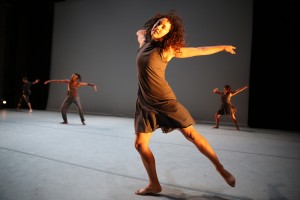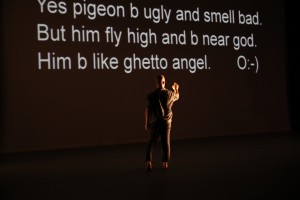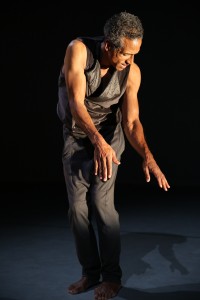
Nehara Kalev in the ‘avant-premiere’ of “Stardust” by David Roussève/REALITY at REDCAT, part of the 2013 international Radar L.A. festival.
Photo: Valerie Oliveiro
Though dubbed an ‘avant-premiere” (the official world premiere is slated for January 2014 at the University of Maryland), there was nothing anemic or glitchy at the Los Angeles opening of “Stardust,” the latest challenging, one-pot dance-theater stew from David Roussève/REALITY. A dogged 85-minute work, “Stardust” was chockablock with ten unique, infallible dancers, a hard-hitting narrative thread developed via projected text messages and Skype-d monologues, and a propulsive aural landscape built from D. Sabela Grimes’ smooth, crisp electronica alternating with Nat King Cole standards.

Nguyen Nguyen standing before video by Cari Ann Shim Sham* in “Stardust” by David Roussève/REALITY. Photo: Valerie Oliveiro
“I no can nevr cry. NEVR!!” was the opening battle-text from an unnamed, unseen narrator, whose painful story of isolation and dissociation was told through (and exacerbated by?) his rabid text messaging into the 4G void. He’s a ‘nigger faggot’ kid who needs counsel and friendship badly, but his text messaging is all one-sided and unanswered, and we watch him fall into ever-worsening traps with a foster dad and a macho footballer from his school. There were several resources for him that balanced the oppression: his texts revealed a gospel-preaching school counselor who tells him of a loving God; plus a wise, luddite Grandpa (played by Rousseve) could be seen rooting for him over an increasingly transcendental Skype. Yet both these voices seemed colorless set against the vitality and drama of the unfolding texts. The only possible counterpoint to the darkness was the music, particularly Cole’s ballads, which coated the jagged narrative with dreamy warmth, enabling another day. Yet by the work’s end, one could argue these rhapsodies had just added further to this kid’s destructive blindness and disorientation.
Roussève’s storylines have always been brutal, but his rapturous presence onstage as dancer/creator in his older works testified to such an undeniable wholeness that moment by moment, no matter the depth of grief evoked, the scenes offered redemptive hope. In “Stardust,” that consolation and integrity was intentionally shuttered. Roussève appeared only in cameo, and there was no other sustained central figure to replace him, just a gray-clad ensemble that he set riffing on a dozen key modern dance phrases, all very low-slung and lateral, with propelling, twitchy, fluttering arms on top. Organic rhythms drove the dance passages; breathing sounds were amplified; chest pops and groin grabs were added into the mix as the plot unfolded. Occasionally, powerful solos and duets emerged, though the relationships were not sustained. When two women who had shrieked into each other’s mouths (Emily Beattie and Taisha Paggett) met up later in a quartet, there was no reference at all to their previous scene. Nor did a deadpan, unaccompanied recitation of Sir Mix-A-Lot’s “Baby Got Back” (by Kevin Williamson) hold much discernable relevance, though it did cut some of the tension.
As the tale unfolded grimly, the repetitive, rocking phrases — cascades of drops and attitude turns and sweeping upper bodies — resurged again and again, as if Roussève’s dancers were trying to redraw the story somehow and lay down the tracks that should have been. Each member of the fresh authoritative cast had a standout moment (other members included Charisse Skye Aguirre, Leanne Iacovetta, Jasmine Jawato, Nehara Kalev, Michel Kouakou, Kevin Le, and Nguyen Nguyen) but for the most part they functioned in ensemble mode, on a stage rarely more designed than a well-spaced dance classroom. Was the choreographic visual inertia and flatness meant to echo the narrator’s frozen sea? Or was
“Stardust” meant to be like like some visual full-body representation of EMDR, that eye-movement therapy that addresses traumatic memory? As with EMDR, which asks patients to talk through devastating memories while simultaneously sweeping their eyes from side to side, “Stardust” featured a strange scaffolding of flowing metronomic movement and heartbreaking (fictive) narration. Yet without a palpable narrator, there were no eyes in this picture. Just a diffuse trail of disembodied movements, motions, reactions, endings. Stardust.
David Roussève/Reality, “Stardust,” REDCAT, 631 W. 2nd St., L.A., September 24-29 2013; www.redcat.org
